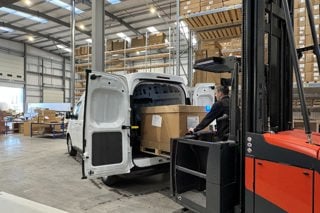This article was first published in the March edition of Fleet News.
Fleet operators buying vans and trucks will benefit from a new super-deduction tax relief, which was announced in the Budget, HMRC has confirmed.
However, tax officials could not guarantee that electric vehicle (EV) charging infrastructure installed on business premises will similarly qualify.
The Government says companies investing in qualifying new plant and machinery, from April 1, 2021, to March 31, 2023, will be able to claim a 130% super-deduction capital allowance, or a 50% first-year allowance (FYA) for qualifying special rate assets.
Expenditure qualifying for the super-deduction would have ordinarily been relieved at the main rate writing down allowance of 18%, while the special rate writing down allowance was 6%.
The super-deduction, says the Treasury, will allow companies to cut their tax bill by up to 25p for every £1 they invest.
“We need to unlock that investment; we need an investment-led recovery,” Rishi Sunak
Delivering Budget 2021 last month, Rishi Sunak, Chancellor of the Exchequer, told MPs: “For the next two years, when companies invest, they can reduce their taxable profits not just by a proportion of the cost of that investment, as they do now, or even by 100% of their cost – the so-called full expensing some have called for. With the super-deduction, they can now reduce their taxable profits by 130% of the cost.”
Under the existing rules, a construction firm buying £10 million of new equipment, for example, could reduce their taxable income in the year they invest by just £2.6m.
With the super-deduction, they can now reduce it by £13m. The Office for Budget Responsibility (OBR) believes it could boost business investment by 10%; around £20 billion more per year.
“Right now, while many businesses are struggling, others have been able to build up significant cash reserves,” explained Sunak. “We need to unlock that investment; we need an investment-led recovery.”
The definition of plant and machinery on some counts will require further clarification from tax officials, but, in terms of investing in vehicles, they were clear.
An HMRC spokesman told Fleet News: “Heavy and light commercial vehicles can qualify for the supered-duction provided they meet the conditions (e.g. new and unused).”
Company cars are not treated as ‘main pool’ plant and machinery for capital allowance purposes, however, so they do not qualify for these reliefs.
When it came to businesses investing in EV charging infrastructure at the workplace, qualification was not as clear cut. HMRC indicated that, for now, it would be a case-by-case decision.
Capital expenditure on EV chargers and costs directly associated with their installation, currently qualify for 100% FYA, which is set to last until March 31, 2023.
Should this spend qualify as plant and machinery, the 30-percentage point uplift will be welcomed by many fleets, which are upgrading their energy and EV charging infrastructure to meet the increasing proportion of plug-in vehicles being operated.
The HMRC spokesman explained: “Provided the electric vehicle charging infrastructure is plant or machinery, critical consideration will then need to be given as to whether the expenditure is main rate or special rate expenditure.”
Only main rate expenditure can qualify for the 130% super-deduction, while special rate expenditure can qualify for the new 50% special rate FYA.
“Generally speaking, integral features of buildings and structures and long-life assets are special rate,” he said. “Electrical systems are included in the definition of integral features so this will need to be considered on the particular facts of the case as to whether the electric vehicle charging infrastructure is an integral feature of a structure or building.”
However, Paul Hollick, chair of the Association of Fleet Professionals (AFP) told the News at 10 webinar, held each month by Fleet News, that the super-deduction could be applied to electric vehicle workplace charge points, and might also apply to home chargers funded by the company, although AFP was waiting for HMRC to verify whether it also included the cost of the groundworks to install the kit.
Tom Callow, head of insight and external affairs at BP Pulse, told Fleet News that, while businesses have benefited for several years from the 100% FYA for expenditure on EV charge points, the new super-deduction of 130% may deliver “even greater benefits to businesses, assuming their particular charge point purchases qualify”.
Adam Hall, head of electric vehicles at Drax, also believes the new relief would make upfront investment in EV charging infrastructure more attractive.
“When combined with other Government grants and subsidies, it gives businesses and fleet operators a strong incentive to transition their fleet to electric sooner rather than later,” he said.
James McKemey, head of insights at Pod Point, agreed, adding that “firms must be profitable to be generating corporation tax bills, and not all are, but for those who are, this can act as a potent incentive to start providing charging infrastructure”.
The history of capital allowances was that up until 2008, if expenditure was on items of plant and machinery with which you carried on your trade, it qualified for capital allowances, but if it was just part of the building it did not. That changed in 2008 and electrical systems were classed as special rate and would have qualified for the 6% tax relief.
Nigel May, tax partner at MHA MacIntyre Hudson, explained: “What we’re trying to find out from HMRC is whether they accept DC charging points as plant and machinery.
“Under the pre-2008 rules, they would, but they are, nevertheless, an electrical system so we’re waiting for a response from Revenue on this.
“Also, for example, if you’re putting a fresh electricity supply in to make your EV charger work, will that be viewed differently from upgrading your existing supply? The devil is in the detail.”
Electrical systems are defined by HMRC as a system for taking electrical power and distributing it through the building or structure. The problem is an EV charge point is a distribution point, says May.
Callow added that it was important for fleet and procurement managers to consider all of the EV charging incentives available to them and their employees, and “not just these capital write-down allowances”.
Read more from AFP chair Paul Hollick on the Budget.






















Login to comment
Comments
No comments have been made yet.